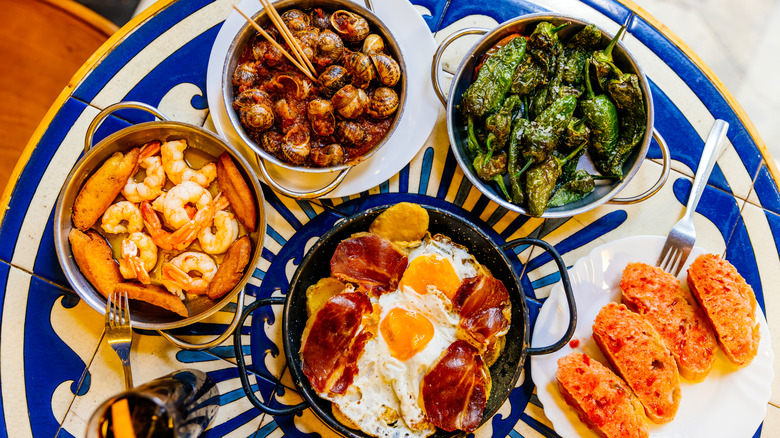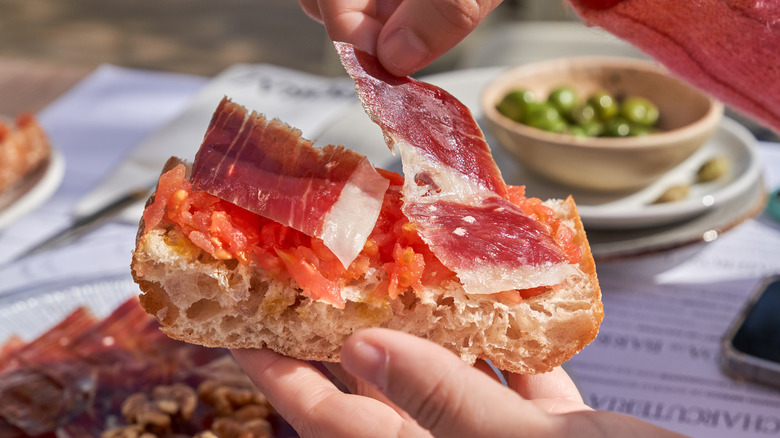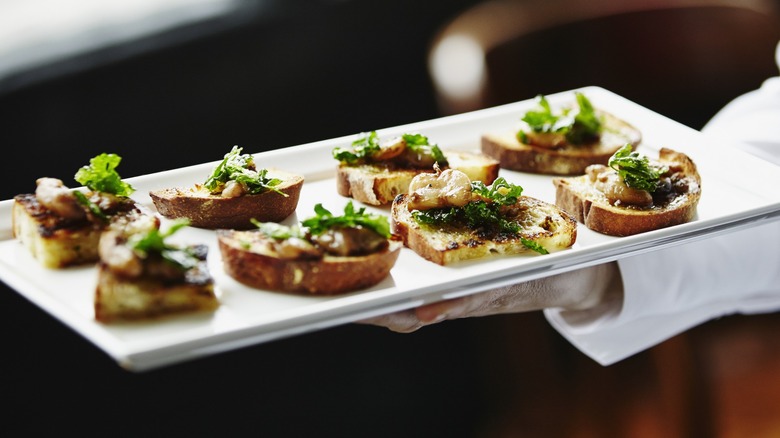Are Tapas Different From Small Plate Appetizers?
Tiny plates can cause big confusion, so we'll get right to the point — tapas are not the same thing as appetizers. While both may look similar in size and presentation, the primary distinction is found in how each type of food is served. Appetizers come before the main course and offer diners satiation before larger portions arrive. Tapas, on the other hand, represent the main course that's been divided into small, delectable bites throughout the duration of a meal. Also, appetizers have an international presence and span many food genres. Tapas are distinctly Spanish, and therefore feature foods from that specific region.
According to StrawPoll, America's most popular appetizers include bread, nachos, wings, and dips. On the other hand, a common spread of tapas may include patatas bravas (crispy potatoes served alongside a spicy tomato-based sauce), cured ham, and the flavor bomb known as the Gilda, an olive, anchovy, and hot pepper medley stacked on toothpick skewers.
Tapas can be further classified as cosas de picar (finger foods), pintxos (skewered dishes), and cazuelas (food served in shallow earthenware bowls). Appetizers have fewer distinctions and reflect the overall cuisine of the establishment or meal. For example, American bar food might include chicken wings and potato skins as appetizers, while an Italian appetizer like bruschetta would be a common precursor to a main course of a classic Italian pasta.
The history of appetizers and tapas reveal more
In a world filled with fusion foods and eclectic menus, tracing the roots of appetizers and tapas can help to further illuminate their distinctions. The concept of the appetizer began in ancient Athens, in the third century B.C. and wasn't exclusively considered a pre-meal snack.
This came into play in the mid-20th century when the National Restaurant Association held a contest to determine a word for a pre-dinner bite. Roy Alciatore, a restauranteur in New Orleans, combined the words "appetite" and "teaser" to create the portmanteau we know today. This firmly seated the term as an exclusive indication of a pre-meal snack versus a standalone smaller meal.
The Spanish tapas tradition is even less clear historically, but there are some cultural tales and etymological hints that help us understand what makes them distinctly categorized as a standalone meal. Some claim that in the late-13th century, King Alfonso X declared it mandatory to serve all alcoholic beverages alongside a morsel of food to discourage excessive drinking.
Another origin theory derives from the meaning of the word "tapar," a verb that means "to cover." Some believe that a plate of tapas was historically purposed to cover the beverage itself, to avoid dust and pests from entering the libation, or that the bites were meant to mask the unsavory flavors of cheaper wine.
What about apertifs and hors d'oeuvres?
Ready to dive in even deeper when it comes to discussing small plates? There are a few additional terms that get as muddled as the appetizer and tapas labels — aperitifs and hors d'ouveres. An aperitif primarily differs from appetizers and tapas in that it's a beverage rather than a food. However, like an appetizer, it's a pre-cursor to a meal, meant to whet the appetite.
It stems from the latin word "apertitiuvum," which literally translates to a meal's "opener." This starter beverage usually consists of low-proof alcohols possessing bitter herbs and notes of acidity. The definitive Aperol Spritz is a common example of an apertif, alongside other spirits like Campari, Lillet, and Sherry.
Hors d'oeuvres, like appetizers and tapas, are small servings of food that aren't meant to replace a full meal in a single portion. But unlike an appetizer or tapas, hors d'oeuvres are more broadly defined as a snack outside of the meal. In fact, an entire event can consist of hors d'oeuvres without an adjoining dinner menu. These finger foods don't require utensils, and are usually smaller than their appetizer and tapas counterparts. They're perfect for mingling rather than eating at the table.
Here's a final cheat sheet for all the terms: Apéritifs open the evening with drinks, hors d'oeuvres keep guests mingling with small bites, appetizers start the meal, and tapas turn eating into a multi-course experience. With this in mind, you'll always make the right choice when enjoying small bites.



